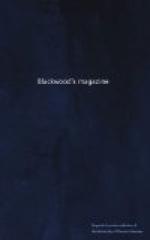In connexion with the chapter “on the feeding of sheep,” we could have wished to advert to the advantages of shelter, in producing the largest weight of meat from a given weight of turnips, or other food—as illustrated by the experiments of Mr. Childers, Lord Western, and others; but we must refer our readers to the passage itself, (vol. ii. p. 51,) as we must also to the no less important comparative view of the advantages of feeding cattle in close byres and in open hammels, (vol. ii. p. 129,) and to the interesting details regarding the use of raw and steamed food, contained in the chapter upon the feeding of cattle, (vol. ii. p. 120 to 148.)
But our author is so cunning in the qualities of mutton—which, as we have already seen, he can “kill so gently,” performing the operation without pain—that we think our readers will enjoy the following passage:—
“The gigot is the handsomest and most valuable part of the carcass, and on that account fetches the highest price. It is either a roasting or a boiling piece. Of black-faced mutton it makes a fine roast, and the piece of fat in it called the pope’s eye, is considered a delicate morceau by epicures. A gigot of Leicester, Cheviot, or Southdown mutton makes a beautiful ‘boiled leg of mutton,’ which is prized the more the fatter it is, as this part of the carcass is never overloaded with fat. The loin is almost always roasted, the flap of the flank being skewered up, and it is a juicy piece. For a small family, the black-faced mutton is preferable; for a large, the Southdown and Cheviot. Many consider this piece of Leicester mutton roasted as too rich, and when warm, this is probably the case; but a cold roast loin is an excellent summer dish. The back-ribs are divided into two, and used for very different purposes. The fore-part, the neck, is boiled and makes sweet barley-broth, and the meat, when well boiled, or rather the whole pottage simmered for a considerable time beside the fire, eats tenderly. The back-ribs make an excellent roast; indeed, there is not a sweeter or more varied one in the carcass, having both ribs and shoulder. The shoulder-blade eats best cold, and the ribs warm. The ribs make excellent chops. The Leicester and




